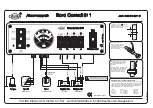
Need help?
https://cellphonesignalbooster.us
Customer Support
Mon.- Fri. Hours: 7 am to 6 pm MST
800-501-3153
11
ENGLISH
Signal Booster Specifications
Drive 3G-X
Model Number
460011
Connectors
SMA
Antenna Impedance
50 Ohms
Frequency
824-894 MHz and 1850-1990 MHz
Passband Gain (nominal)
800 MHz
47.8
1900 MHz
44.2
20 dB Bandwidth (MHz)
800 MHz
1900 MHz
Typical
Maximum
37.8
39.4
79.4
80.4
Power output for single cell phone (dBm)
800 MHz
1900 MHz
Uplink
Downlink
29.0
-7.9
27.1
0.7
Power output for multiple received channels
(Uplink) dBm
No. Tones
800 MHz
1900 MHz
2
26.7
24.2
3
23.2
20.6
4
20.7
18.1
5
18.8
16.2
6
17.2
14.6
Power output for multiple received channels
(Downlink) dBm
No. Tones
800 MHz
1900 MHz
2
-14.3
-15.5
3
-17.8
-19.1
4
-20.3
-21.6
5
-22.3
-23.5
6
-23.9
-25.1
Noise Figure (typical downlink/uplink)
4 dB nominal
Isolation
> 90 dB
Power Requirements
12-15 V, 2 A (subject to uplink power)
The Manufacturer’s rated output power of this equipment is for single carrier operation. For situations when multiple carrier signals are present, the
rating would have to be reduced by 3.5 dB, especially where the output signal is re-radiated and can cause interference to adjacent band users. This
power reduction is to be by means of input power or gain reduction and not by an attenuator at the output of the device.
Each Signal Booster is individually tested and factory set to ensure FCC compliance. The Signal Booster cannot be adjusted without factory reprogramming or disabling the hardware. The
it will reduce gain until a signal is detected. If a detected signal is too high in a frequency band, or if the Signal Booster detects an oscillation, the Signal Booster will automatically turn the
problematic bands are permanently shut off until the Signal Booster has been manually restarted by momentarily removing power from the Signal Booster. Noise power, gain, and linearity
are maintained by the Signal Booster’s microprocessor.






























